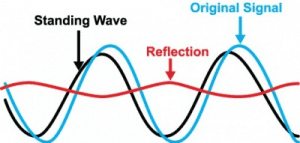Filter Types and Topologies
In any wireless or RF system, unwanted interference is the enemy. These interfering frequencies can be generated by many sources. From self-generated harmonics under amplification or nonlinear mixing diode products to the numerous signals being broadcast in the increasingly congested open air, the need for preserving signal and system integrity is an absolute must. Properly applied filtering is a must when trying to optimize your RF system.
Filters allow intended RF signals to pass through with minimal attenuation while significantly reducing RF energy of signals not in the passband. RF Filters come in five different varieties: Low-pass, High-pass, Band-pass, Band-stop or Notch, and the less common All-pass. Each of these filter types has its proper place in mitigating interfering signals and preserving an RF system to be able to perform as optimally intended. The different types of filters are named so because they do what the name implies. Below we will briefly describe the four most common filter types used in RF systems.
Filter Types
Low-Pass
An ideal low-pass filter is designed to pass RF energy from DC up to a cutoff frequency and attenuate all signals above that cutoff. The slope of rejection above the cutoff frequency is dependent upon the filter topology and filter order. The higher the filter order becomes, the more attenuation is achieved with increasing frequency. Low-pass filters are commonly used to suppress harmonics at the output of a power amplifier, synthesizer, or mixer.
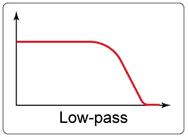
High-Pass
An ideal high-pass filter is designed to pass RF energy at a cutoff frequency to infinity and attenuate all signals below the cutoff frequency to DC. The same principles apply to a high-pass as with a low-pass with regard to the attenuation slope. These filters are commonly used to suppress low-frequency noise generated by power supplies or to reject low-end mixing products.
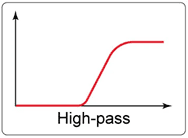
Band-Pass
An ideal band-pass filter is designed to pass RF energy between two band edge frequencies and reject all other frequencies below the low band edge and above the high band edge. These filters are well suited for a fixed RF system that always operates at known frequencies and needs to reject potential interferers above and below the band of operation.
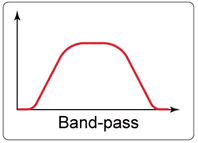
Band-Stop (Notch)
An ideal band-stop filter, or commonly referred to as a notch filter, is designed to reject a single frequency or band of frequencies and pass all others above and below the rejection band. The band-stop is the inverse of a band-pass filter. These band-stop or notch filters are used to reject a known interfering RF signal; commonly incorporated on an antenna receive path for known nearby radiated signals.
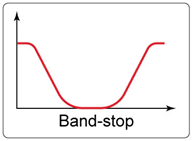
Filter Topologies
All these filter types can be designed using several different techniques or topologies to bring about the most optimal response. The Bessel filter offers superior phase shift (delay) but lacks in sharp cutoff. Next, the Butterworth filter which is commonly referred to as a “Maximally Flat” filter because the passband response offers the steepest roll-off without inducing passband ripple but with greater delay and poor phase linearity. Third the Chebyshev filter offers a steep cutoff response but introduces ripple into the passband (Chebyshev Type 1) or stopband (Chebyshev Type 2), this ripple introduces poor phase linearity, but it can be overcome by increasing the bandwidth. Lastly, the Elliptic (Cauer) filter offers the steepest possible roll-off of all filter types mentioned here but consequently has a ripple in both the passband and the stopband.
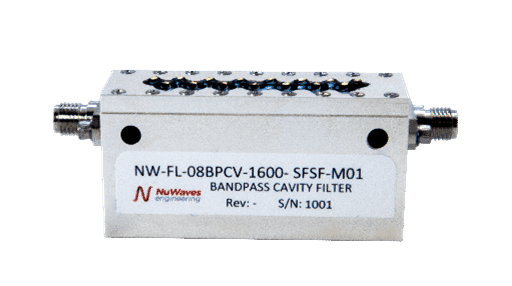
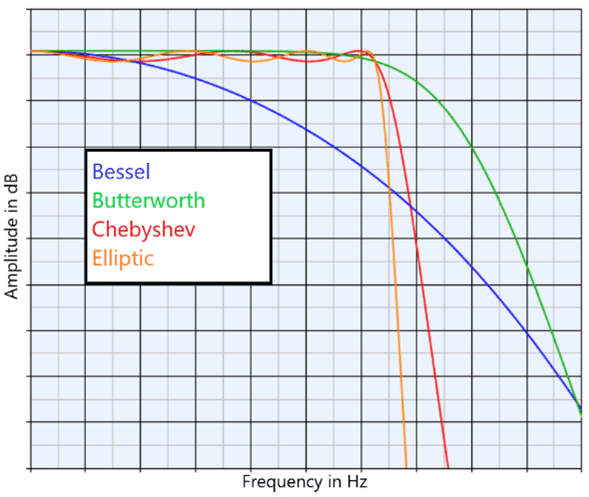
Customizing to Fit Your Needs
All these filter types and topologies have their place in an RF system to mitigate interference while preserving system integrity. At NuWaves RF Solutions, we specialize in designing filters best suited for our customers’ needs. We offer several filters in our catalog ranging from UFH upwards through K band.
We also offer custom filter designs that can be specifically tailored to your system’s needs. Whether you need a High-Power handling low-pass cavity filter on the output of a Power Amplifier to reduce harmonics and spurious signals or a specifically tuned band-pass filter for your RF receiver NuWaves RF Solutions can provide a custom solution to optimize your system. Our specialized engineers have decades of experience designing advanced filter solutions with unmatched precision from prototyping to deliverables.
At NuWaves we have in-house capabilities to design, prototype, machine, tune, and test all under one roof. We pride ourselves in our quick-turn approach to offer the best solution in the shortest amount of time with delivery times as soon as two weeks. NuWaves’ filters can be found in everything from drone command and control technology to SATCOM systems and more.

